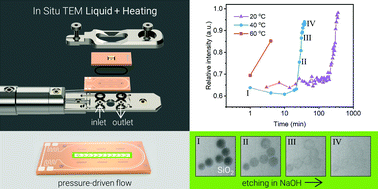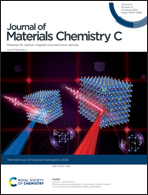Liquid phase transmission electron microscopy with flow and temperature control†
Abstract
Liquid phase transmission electron microscopy has become a powerful tool for imaging the structure and dynamics of materials in solution. Direct observation of material formation, modification and operation has provided unique insights into the chemistry that governs the structure–property relationships of materials with myriad applications including optical, magnetic and electronic materials. However, full control over the reaction environment inside the microscope, especially the solution temperature and concentration of reactants, remains challenging and has limited the application of this high-resolution methodology. Here we present the ‘Stream Liquid Heating Holder’, a complete system for liquid phase experiments at elevated temperature inside the transmission electron microscope. This system features a unique on-chip flow channel combined with a microheater. The channel enables direct flow over the imaging area and rapid replenishment of the solution inside the Nano-cell with simultaneous heating to more than 100 °C. The capabilities of the system are demonstrated by studying the liquid flow dynamics and comparing the temperature dependent etching kinetics of silica nanoparticles by in situ liquid phase electron microscopy to in-flask experiments.

- This article is part of the themed collections: Journal of Materials Chemistry C Emerging Investigators and 2020 Journal of Materials Chemistry C most popular articles


 Please wait while we load your content...
Please wait while we load your content...